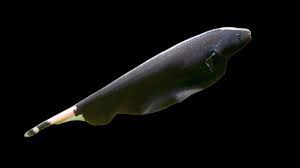Black Ghost Knifefish (Apteronotus albifrons)
Black Ghost Knifefish Care Guide
Tank Setup
-
Tank Size: Minimum 300 liters (75 gallons) for one adult; they can reach 50 cm (20 inches) in length.
-
Substrate: Soft sand or fine gravel to prevent damage to their sensitive skin.
-
Décor: Provide driftwood, caves, PVC pipes, and dense plants for hiding. They are shy and nocturnal, so plenty of cover is essential.
-
Lighting: Dim or subdued, as they prefer low-light conditions.
Water Parameters
-
Temperature: 24–28°C (75–82°F)
-
pH: 6.5–7.5
-
Hardness: 0–10 dGH (soft water preferred)
-
Filtration: Strong filtration with gentle current – they need clean, well-oxygenated water.
Diet
-
Carnivorous: Feed live or frozen foods such as bloodworms, brine shrimp, blackworms, and small pieces of shrimp or fish.
-
May accept sinking carnivore pellets once settled, but live/frozen food should be the staple.
-
They hunt using a weak electric field, helping them locate prey in the dark.
Tank Mates
-
Peaceful but predatory.
-
Suitable companions include large, calm community fish (angelfish, discus, silver dollars, gouramis, peaceful cichlids).
-
Avoid aggressive species or very small fish, which may be eaten.
-
Best kept singly, as they can fight with their own kind unless in very large aquariums.
Behavior
-
Nocturnal, shy, and intelligent.
-
Swim gracefully using their elongated fin that ripples along the underside of the body.
-
Use electrical signals to navigate, hunt, and communicate.
Breeding
-
Extremely difficult in captivity.
-
They are known to breed in large river systems in the wild, and successful home breeding is very rare.
Interesting Fact
The Black Ghost Knifefish is used in biological research because of its electric organ, which generates weak electrical fields. This unique ability allows it to navigate and hunt in murky waters, making it one of the most fascinating aquarium fish.

